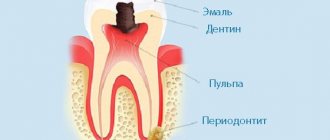We understand what causes unpleasant sensations in a “dead tooth” and determine how to solve the problem. Most of us go to the dentist to restore the beauty of our smile or get rid of painful sensations. One of the most common dental operations is removal of the dental nerve. Of course, at the end of therapy, the patient expects that pain will no longer bother him.
However, quite often a treated tooth without a nerve with a filling or under a crown begins to hurt. To understand why a tooth without a nerve hurts, you need to find out how the pulp removal procedure occurs and figure out what exactly causes the pain.
Can a dead tooth hurt?
Before answering this question, let’s find out what the concept of “dead tooth” means? This is the common name for a tooth in which, for medical reasons, the pulp has been removed - loose fibrous tissue penetrated by nerve endings, blood and lymphatic vessels. We are talking about depulpation (removal of the pulp) in case of inflammation for various reasons: due to advanced caries, fistulas, cysts, etc.
Calling a pulpless tooth “dead” is not entirely correct. It is indeed separated from the circulatory system and the nervous system, but is still a component of the dentofacial apparatus, where each element affects the condition of the others.
Pain in a tooth with a removed nerve most often means that other parts of the system are involved in the pathological process, “transmitting” unpleasant sensations to the tissues associated with this tooth. Thus, a false impression is created that the pulpless tooth hurts.
How to treat a tooth with a crown
When the nerve under the crown of a tooth hurts, treatment is carried out differently depending on the clinical situation and X-ray data. Today, treatment is increasingly carried out through a drilled hole in the prosthesis. But sometimes the crown should be removed and only then the necessary treatment should be carried out. Mandatory removal of the structure is required when:
- rapidly developing deep caries, complicated by pulpitis and periodontitis;
- incorrectly installed crown or its destruction;
- allergies to prosthetic material;
- abscess, cyst in the area of the apex of the tooth root.
After treatment, the orthopedic structure is reinstalled. This can be an old crown (if it is completely preserved) or a new one (if the tooth has acquired a different shape after treatment). After treatment, the hole in the crown is sealed with a light-curing filling material.
Removing a crown for tooth treatment
"Living" tooth
This is a unit with no pulp removed. Most often, it performs a supporting function in a bridge prosthesis. If for some reason secondary caries develops in it, the artificial structure is removed under local anesthesia or a hole is drilled in it. The tooth cavity is opened, the pulp is removed, the root canals are cleaned and a complete filling is performed. After this, a crown is installed or the hole made through which the treatment was performed is repaired.
With the nerve removed
A pulpless tooth does not have a nerve (pulp). Pain is associated with problems in the area of the tooth root. To determine the cause of the pain, x-rays are performed. Treatment can take place both with the crown removed and through a drilled hole. The root canals are cleaned, foreign bodies and excess cement are removed. Treat or remove abscesses, cysts, granulomas. Then re-prosthetics or restoration of the integrity of the crown is carried out using photo-curing materials.
Why does a dead tooth hurt when pressed?
Pain in a tooth without a nerve when biting or pressing can be due to various reasons, and is not necessarily explained by pathology. In the first days after depulpation, discomfort when pressing occurs as a reaction to the procedure itself.
It should be understood that nerve removal and preparation for filling is a microsurgical operation that is impossible without tissue injury. First, the dentist drills out the tooth cavity, then, using special tools - an apex locator and needles of various tapers - penetrates the root and extracts the nerve. Then anti-inflammatory and antibacterial drugs are placed into the cleaned channels.
Post-filling pain
If a filled tooth with a removed nerve hurts for some time, this may be normal, as it can be explained by objective reasons.
- In preparation for a filling, slight damage to the healthy tissue involved in the process may occur. Most often, this is the cause of pain in a dead tooth when pressed. Pains of this origin are called post-filling; they are moderate in nature and, as a rule, disappear after a few days. To relieve discomfort, the doctor usually prescribes painkillers.
- Unpleasant sensations may arise due to the characteristics of the filling material, which expands slightly when entering the root canals and creates pressure on the apex. These pains are temporary and disappear without a trace after a few days.
Intense pain in the tooth under the filling, its sharp increase a few days after the filling and the absence of a tendency to subside after one or two weeks are no longer the norm. This indicates the presence of complications and requires an urgent visit to the dentist's office.
Poorly performed treatment
The cause of pain in a treated tooth due to mechanical action (pressure, biting) may be errors made during endodontic treatment.
- Perforation of the tooth root.
Improper treatment can result in the filling paste extending beyond the root apex into the jawbone tissue. Inflammation under the tooth develops around the foreign body, causing first bursting and then throbbing pain. - Incomplete closure of root canals.
If the length of the canal is incorrectly assessed after filling, part of the cavity remains unfilled, infection develops in the voids, and as a result, when tapped, a tooth without a nerve hurts. - Incomplete depulpation.
If a tooth without a nerve hurts when pressed, this may indicate that the pulp was removed poorly and living tissue remains in the canals. - Poor saliva evacuation.
As a result, pathogenic microorganisms can enter the canal cavity along with the remaining saliva, which leads to tissue infection and pain. - A fragment of a tool in the canal.
Very thin needles used to examine tooth root canals sometimes break and some remain inside, serving as a source of pain and infection. - Specific root structure.
The condition for successful treatment is a completely sealed root system. Some branches, due to the non-standard structure of the apex, are not visible even on an x-ray, and then the dentist is not immune from making a mistake. - The filling is too high.
The ligaments that support the tooth experience increased stress, stretch, and discomfort and pain appear. - Poor quality removal of tissues affected by caries
, which are a source of pathogenic microflora and cause pain in the tooth under the filling.
Pain and swelling of the gums with quality treatment can also be caused by an allergy to a certain type of filling material. In such a situation, the dentist prescribes antihistamines and analgesics.
Cyst
If the nerve has been removed a long time ago—a year or more—and suddenly begins to hurt, the cause may be a root apex cyst. This disease occurs mainly in those teeth that have been subjected to depulpation and treatment. And since the pulp is removed during infection, the likelihood of a cyst subsequently forming is very high.
Inflammation of the trigeminal nerve
A situation where a filled tooth without a nerve hurts when biting or pressing can be caused by trigeminal neuritis. There is no mistake by the dentist here: inflammation can be caused by the treatment process itself. The pain can be constant, paroxysmal, throbbing. In this case, it is not the tooth that needs to be treated, so a neurologist deals with this problem.
Features of nerve removal
Experienced doctors perform depulpation only as a last resort. But sometimes it is impossible to do without it. What is the procedure? First, an x-ray is taken, from which the dentist draws conclusions about the condition of the pulp (nerve tissue), areas around the root and gets an idea of how deep the inflammation has spread. The specialist assesses the length of the nerve and the features of its location, then gets to work and acts in several stages:
- anesthesia: local anesthesia to relieve the patient of inevitable discomfort. Modern drugs make it possible to carry out all manipulations absolutely painlessly,
- caries removal: the dentist drills out the affected areas of enamel and dentin using a drill,
- nerve removal: using a special tool called a pulp extractor, which is screwed into the canal, the dentist removes the neurovascular bundle in several stages,
- expansion and cleaning of the canals: carried out so that the doctor can efficiently clean the canals from remnants of nervous tissue and prepare them for filling. The channels are expanded with thin burs, which help to level and smooth the inner surface of the walls,
- filling: a material specially designed for filling (for example, gutta-percha) is injected to the entire depth of the root. The consistency of this substance allows you to fill the cavity entirely so that there are no empty areas left there. The upper part is covered with composite material. In some cases, a large inlay is placed or a crown is installed over the filling.
A tooth left without a nerve is called “dead.” It becomes insensitive to irritants, and enamel mineralization stops. It loses its whiteness and acquires a dark shade. To restore an aesthetic appearance, the dentist may suggest performing intra-canal whitening, installing a veneer or an aesthetic ceramic (or metal-ceramic) crown.
Pain under the crown when pressing
If after dentures there is pain under the crown of a dead tooth when biting, there may be several reasons. The tooth begins to hurt due to mechanical stress in the near future after prosthetics in the following situations:
- poor-quality filling, which was already mentioned earlier;
- due to incorrectly chosen shape or size of the crown, poor fit to the tooth;
- The fixation of the prosthesis is impaired due to an insufficient amount of cement: this allows food to get under the crown and the development of infection.
If pain does not occur immediately, but some time after installation of the prosthesis, this may be due to the following factors:
- violation of the tightness of the filling, crown;
- improper care of dentures and poor oral hygiene, which contributes to tissue infection and inflammation;
- the expiration date of the prosthesis (usually about 5 years).
Another reason for rapid tooth destruction under the crown, resulting in pain, is treatment with potent drugs for severe diseases, chemotherapy, and radiation exposure.
Attention! Unpleasant sensations without acute pain immediately after prosthetics are accompanied by the process of getting used to the crown. This goes away within two to three days after completion of the procedure. If the pain does not go away within the specified time, but rather intensifies, you need to urgently go to the doctor.
We correct other people's mistakes. Dental retreatment with a 10% discount
Moscow
Causes of depulpation
There are a number of indications for dental nerve removal. Depulpation is most often carried out in the following cases:
- with extensive carious lesions affecting the dental nerve;
- development of infection in the dental canal;
- mechanical damage to the pulp;
- In the process of preparing for prosthetics, even a healthy pulp may be removed; this is necessary to eliminate the risk of developing re-inflammation in the tooth after the installation of an orthopedic structure.
The procedure for removing pulp from a tooth is performed in the following sequence: 1. Based on an x-ray taken, the doctor determines the structure and size of the dental canals. 2. Local anesthesia is administered. 3. The pulp is removed first in the coronal and then in the root part of the tooth. 4. Dental canals without pulp are carefully treated with an antiseptic solution. 6. After treatment, the canals are sealed. 7. Most often, a temporary filling is subsequently placed on the tooth, which later must be replaced with a permanent one.
What symptoms should you see a doctor for?
What to do if a tooth with a removed root hurts under the filling when pressed? During the first few days, do not panic and observe the nature and intensity of the pain. Pain during the week after filling may be a normal reaction of the body to surgical procedures. In what cases do you need to urgently contact the clinic?
- If within 5-7 days the pain does not go away, intensifies, changes its character to acute, pulsating;
- swelling of the gums appears;
- there is an increase in body temperature.
In such situations, you need to urgently see a dentist so as not to worsen the situation.
Possible complications and consequences
If you do not consult a specialist in time for severe pain in a pulpless tooth, the following serious complications may occur: 1. Purulent inflammation in the tooth (granuloma). 2. Formation of a cyst in the tooth. 3. Loss of the affected tooth. It should be remembered that pain in a pulpless tooth can be normal only in the first few days after treatment. Under other circumstances, the presence of pain in the tooth most likely indicates the development of a pathological process that must be eliminated as soon as possible. In most cases, the appearance of pain when pressing on a tooth or chewing food indicates poor quality treatment. If toothache does not go away a few days after dental procedures, then there is no need to hesitate to visit the dentist. Only a doctor can determine the condition of the tooth, identify the cause of concern and prescribe the necessary treatment. Complications that may develop due to the lack of necessary treatment are much more difficult, longer and more expensive to treat. In addition, lack of treatment can lead to diseases of neighboring healthy teeth. In order not to detect diseases at the complication stage, you need to regularly, every six months, visit the dental clinic for a preventive examination by a specialist. At the Innovative Dental Clinic on Marata-31, dentists conduct free medical examinations for their patients. The clinic employs competent specialists with extensive experience. Treatment in the clinic is carried out using modern equipment, in compliance with all regulatory standards of dental treatment. You can make an appointment with specialists on our website using the online appointment form or by phone. We work seven days a week and will always be happy to find a convenient appointment time for you. Sign up, with us your teeth will be healthy!
What complications may arise?
Pain in a dead tooth necessarily indicates the presence of some pathology that needs to be eliminated in a timely manner. Infection can lead to serious consequences:
- complete destruction and death of the tooth;
- chronic gum inflammation;
- development of periodontitis, gingivitis;
- the appearance of cysts.
In addition, failure to seek medical help in a timely manner can lead to the development of systemic infections that spread from the periosteum through the bloodstream throughout the body!
How to relieve pain at home
With moderate syndrome, you can cope with pain using traditional recipes.
- Rinsing with a soda-salt solution will help alleviate the condition; decoctions of medicinal plants: oak root, sage, chamomile, calendula.
- A paste of garlic and onion or a piece of propolis is applied to the diseased tooth.
- The submandibular area on the sore side is massaged for one and a half minutes.
For disinfection, rinsing with the antiseptics chlorhexidine and miramistin is recommended. In order not to endure severe pain while visiting the dentist, you can take medical anti-inflammatory and painkillers: aspirin, analgin, Ketanov, Nurofen; treat the problem area with Dentcos and Kamistad gels.
Important! You should not heat the affected area (this will increase inflammation), or use painkillers for a long time without a doctor’s prescription. All of the above measures will help temporarily relieve pain, but will not stop the process.
Is it possible to cure a tooth on your own?
Remember: it is impossible to cure a tooth on your own, without the help of a specialist!
All means - medications, folk recipes - have only a temporary, disinfecting and alleviating effect. To get rid of pain, you need to make a correct diagnosis and eliminate the cause, and this can only be done by a dentist in a specialized medical institution using modern diagnostic and treatment technologies. Recommendations for self-treatment of a tooth under a filling can lead to the development of complications even faster.
Treatment of a dead tooth in dentistry
The treatment method for pain in a tooth with a removed nerve depends on the reasons that caused this condition. The dentist will conduct an examination and, if necessary, prescribe an x-ray examination.
- If the cause is unsatisfactory treatment, the filling material is removed, preparation is carried out again, and the canals are inspected with medications placed in them. Then, when the condition returns to normal, the tooth is refilled.
- If the roots are curved, it may be necessary to remove the part that prevents the canals from being cleaned and sealed.
- The cyst or granuloma must be surgically removed along with the pathologically changed tissues around it.
- If there is inflammation of the gums, complex treatment is prescribed. This includes professional teeth cleaning with stone removal, placing medications in periodontal pockets, and taking systemic medications.
- If indicated, physiotherapy procedures are prescribed that have a therapeutic effect on hard tissues.
Remember: by delaying a visit to the dentist, hoping that the pain will go away on its own, you increase the likelihood of serious complications, the treatment of which will be lengthy and possibly expensive.
What to do if your teeth react to heat?
You can get rid of unpleasant pain and discomfort only after the cause of hyperesthesia has been established. Only by eliminating it with the help of competent treatment can you forget about the pain. For this purpose, the following treatment methods are used in modern dentistry.
- Fluoridation of enamel.
- Mineralization procedures.
- Sealing of fissures.
- Correction of bite pathologies.
- Placing a filling.
- Surgical gum lift.
- Installation of veneers, lumineers.
- Crown installation.
The choice of one or another treatment method depends on the type, shape and severity of the pathological process that led to damage or thinning of the hard tissues of the tooth.
It is important to know! At first, a healed tooth with a filling, under a crown, or after other procedures may bother you, continuing to react to hot, cold and other irritants. If within 7–10 days the pain does not go away or intensifies, then you need to contact your dentist again.
Treatment at home
For treatment at home, various means are used to help restore the protective functions of the enamel, thereby reducing tooth sensitivity. These include various gels, varnishes, creams, foams and powders with active ingredients. The most popular of them are the following.
- Varnish "Bifluoride 12".
- Dental cream "MI Paste Plus".
- Gel (or solution) “Fluocal”.
- The drug "Ftorlak".
- Dental gel "Tooth Mousse".
- Powder for Remodent solution.
- 10% calcium gluconate solution.
- Strontium chloride paste 75% or its 25% rinse solution.
The listed products are used according to the manufacturer's instructions, after preliminary consultation with a dentist and attending physician. Possible contraindications and complications!
More harmless and less effective means include special toothpastes and mouthwashes.
- "Oral-B Sensitive Original".
- Sensodyne-F.
- "MEXIDOL dent sensitive".
- "Rembrandt Sensitive".
Recently, active research has been carried out aimed at creating a toothpaste capable of filling (sealing) microholes in tooth dentin. However, they are not very successful, since any active component currently known to science cannot penetrate into a hole 1-4 microns wide to seal it. Therefore, the promises of toothpaste manufacturers should be treated reasonably and, partly, skeptically.
Prevention
You should not think that a tooth with a removed nerve, deprived of blood supply, will relieve you of dental problems - you have already seen this. On the contrary, such teeth are problematic and therefore require more careful care. They are susceptible to any dental diseases - perhaps, except for pulpitis.
- The main means of prevention is thorough oral hygiene 2 times a day using a brush, dental floss, and mouthwash.
- A balanced diet containing enough vitamins and minerals will help keep your teeth longer.
- Regular visits to the dentist - at least once every 3 months - will make it possible to recognize the problem at the initial stage.
And remember: the best prevention of toothache is not to let the tooth need to be depulped, because the likelihood of subsequent complications is very high.
Author: Elena Kopylova Dentist-endodontist. Work experience more than 12 years.
The information is for reference only. Before treatment, consultation with a doctor is necessary.











